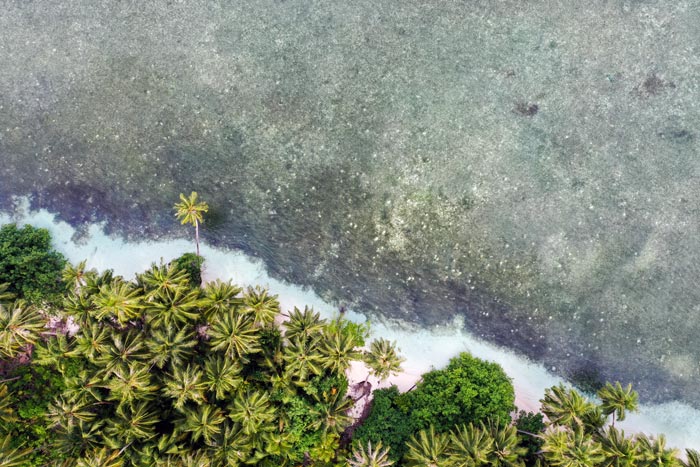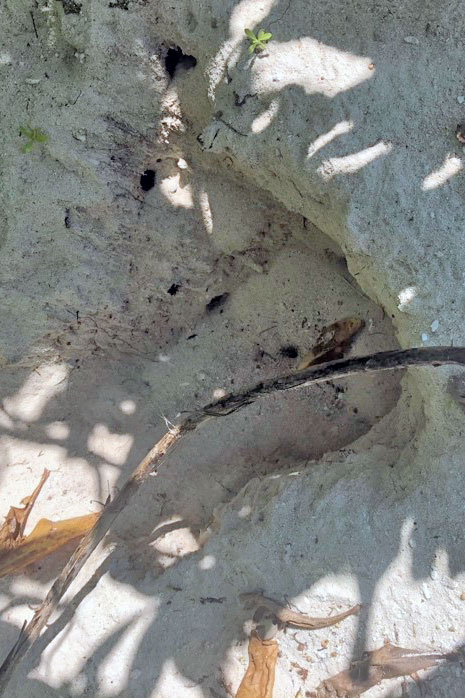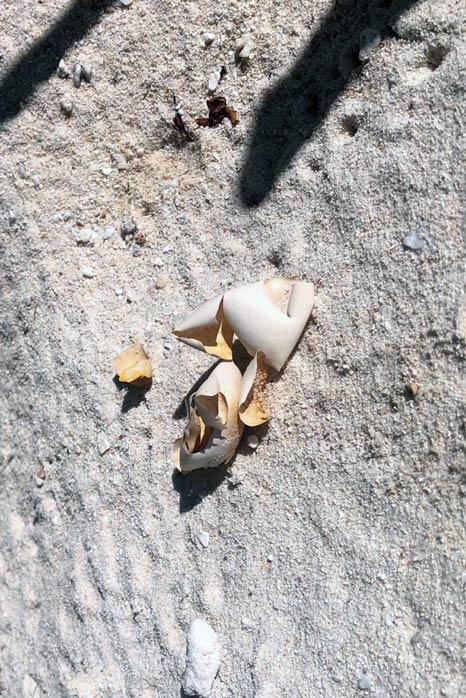L. Gaadhoo sits at the mouth of the largest ocean channel opening in the Maldives. This vantage point is the perfect place to see the abundance of megafauna in the atoll. From sharks to rays to dolphins — there is always something amazing to see for those cruising by the island. Yet, what makes Gaadhoo stand out on a national stage is its beach; Gaadhoo’s beach is home to the highest number of green sea turtle nests in the Maldives.
Sea turtles: ancient reptiles
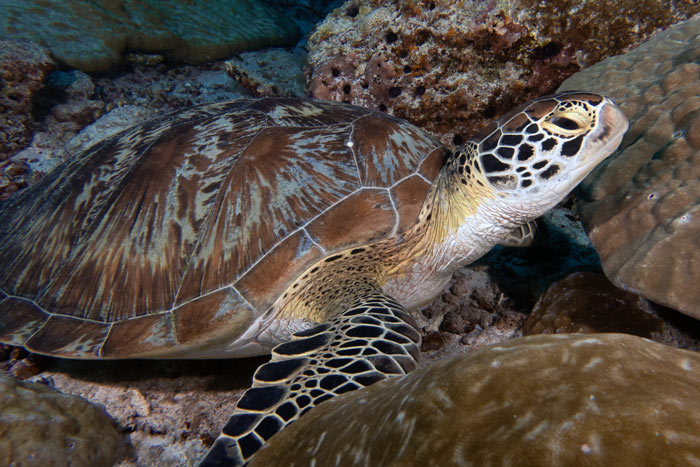
Sea turtles are part of an ancient lineage of reptiles; their roots date back to a time before the dinosaurs! They have special adaptations that help them stay underwater for long periods of time, but they still need to come up for air. While sea turtles can hold their breaths between 5-7 hours when they’re resting, they regularly surface when they are feeding or swimming. And sometimes just to bask in the sun at the surface! Sea turtles are poikilothermic. This means that their body temperature varies and depends in part on their surroundings. This is also why many sea turtle species are found in tropical waters, like the Maldives, where the water temperature is consistently close to optimal internal body temperature for these species.
Yet, the Maldives is not the only place where they live! Sea turtles are migratory and their habitat use changes throughout their lives. They spend their early years navigating ocean currents in the open seas until they have reached a certain size, at which it will be safe for them to venture into more predator dense feeding grounds closer to shore. Sea turtles can be very loyal to those feeding grounds and only leave them to return to nest in the same area that they hatched.
Green turtles: vegetarian giants
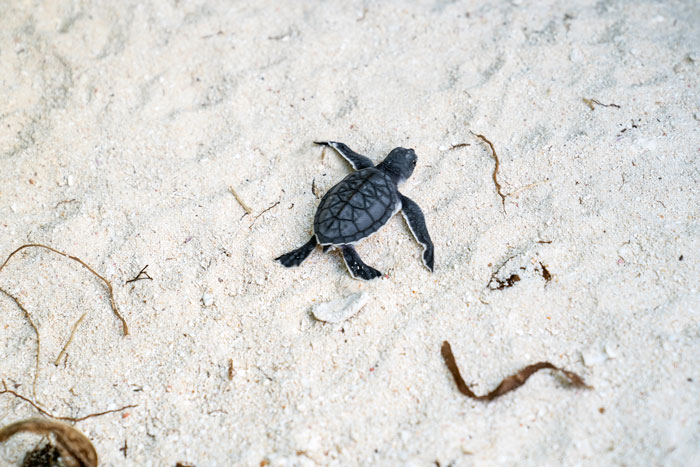
Green sea turtles are the largest hard-shelled species of turtles in the oceans and reach sizes of up to 134 cm. They will in particular seek out seagrass meadows as they are herbivores and primarily munch on seagrass and algae. They actually get their name from consuming so many greens that their fatty tissue takes on a greenish tint! Green sea turtles’ constant grazing and removal of algae from the reef also keeps the seagrass beds and reefs healthy.
The most difficult habitat for green sea turtles to reach is the nesting beach. As marine animals adapted to life at sea, dragging their body up the beach and digging a hole to bury their eggs and hide them from predators can be a daunting process. 1/10 of their hatchlings have a natural chance of survival due to predation by crabs, birds, sharks, and fish, however, human interference and the plastic in our oceans have dramatically reduced that number to 1/1000.
Since 1978, the green sea turtle has been listed as Endangered on the IUCN Global Red List of Threatened Species, as they are at risk of becoming extinct in the wild in the near future. They are also listed as endangered on the National Red List for the Maldives.
Gaadhoo Island, its sea turtle nests, and its people
Laamu Atoll is a very special place for green sea turtles in the Maldives. Of the 14 islands decreed as sea turtle nesting hot spots by the Maldivian government in 2006, Gaadhoo island in Laamu Atoll was regarded as the most significant green sea turtle nesting beach in the country.
While official records documenting the sea turtle population of the Maldives are scarce and without too much detail, they do date back to the 1900s. However, these records focused on sea turtles in the water and sea turtle consumption, only rarely even mentioning nesting activity. Following many oral reports and benefiting from local knowledge on sea turtle nesting, initial strategic surveys of nesting activity were initiated in the 1980s.1
At that time, the annual estimate for Gaadhoo was 240 nests a year1, with nesting activity peaking between June and December. The inhabitants of Gaadhoo at the time recounted an average of up to 5-10 sea turtles nesting per night in the past! Gaadhoo’s residents used to act as custodians of the nesting beach. They would conduct regular beach patrols to protect the area from hunters and harvest a small number of eggs to be distributed these among residents. The income generated was used for community projects2. Following the 2006 egg harvesting ban, the beach patrols ceased, and the island became subject to uncontrolled illegal take acticity2.
When the people left
In 2015, the residents of Gaadhoo were moved to a different island due to their small population4. Currently, with no permanent residents whose presence could deter hunters, illegal take remains a prevalent issue on Gaadhoo. The Maldives Marine Research Institute estimated that 142 nests were laid a year on Gaadhoo in 2016. This constitutes a 40% decline in nesting from the 1980s2. It is therefore important to continue to monitor the nesting beach of Gaadhoo to conserve the green sea turtles of Maldives.
Nesting surveys on Gaadhoo
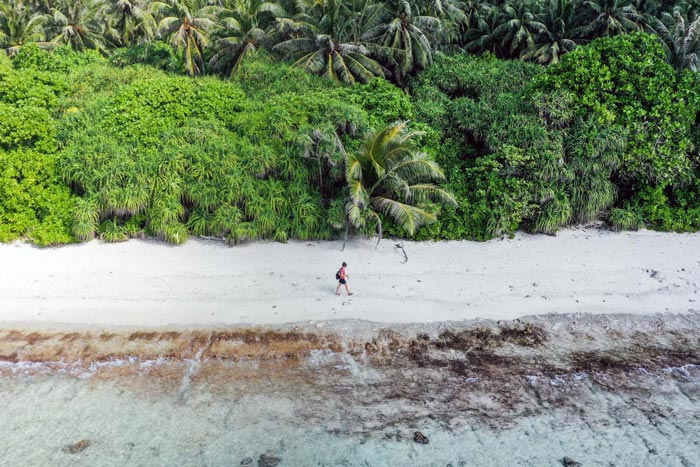
ORP partnered with Six Senses Laamu in 2018. Since then, ORP staff have conducted ad-hoc nesting surveys on Gaadhoo. We recorded 76 suspected nests between May 2018 and March 2019, and 56 between April 2019 and February 20203. Recorded nest numbers during both survey periods were significantly higher than nest numbers on the neighboring island Olhuveli with 29 and 24 respectively.
Fewer suspected nests on Gaadhoo showed signs of illegal take activity in 2019-20 (37.5%) than in 2018-19 (68.4%). This decline in illegal take activity could be the result of the presence of researchers on the island. Ali and Shimal (2016) noted that regular surveys on nesting beaches were associated with an appreciable decline in illegal take. We recorded nesting activity during all months of the year, but no consistent seasonal pattern3.
It is normal for nesting activity to fluctuate between seasons, as sea turtles do not nest every year. Still, let’s take a moment to think about the above with these turtle facts in mind:
- Sea turtles return to the same to general area where they hatched to nest
- It takes green sea turtles between 20-50 years to reach sexual maturity
- They can lay between 2-8 nests per season, with a break of ~14 days in between
- A nest has about 110 eggs on average, and can vary between 80-200 eggs
- Estimates say only 1/1000 hatchlings survive to adulthood
Gaadhoo’s nesting sea turtles are key in ensuring the survival of the population of green sea turtles in the Maldives. While nesting data may vary yearly depending on the migratory intervals of sea turtles, the island continues to promote the lineage of these ancient reptiles.
Gaadhoo – a haven for many
In addition to its importance for sea turtles, Gaadhoo is also a haven for many other species. Migratory birds navigate to its mangroves during the northeast monsoon. Juvenile fish are using its seagrass meadows as a nursery, and the reefs surrounding the island provide a home to many species vulnerable to, or even threatened with, extinction.
Gaadhoos seagrass meadows are unique even in Laamu! 38% of the 91 fish species found in Gaadhoo were not found in any other seagrass meadow studied in the atoll5. With 39 different genera of corals in its reefs, and at least 5 different species of seagrass, Gaadhoo is full of life and shelter!
Laamu Atoll is lucky to have such an exceptional island with rich biodiversity and history that even the turtles recognise as being unique. Our hope for Gaadhoo is that it continues to be a sanctuary for animals – especially for green sea turtles.
In Laamu ORP operates under the umbrella organisation Maldives Underwater Initiative along with The Manta Trust and Blue Marine Foundation. MUI is a conservation initiative by Six Senses Laamu with a mission to lead the tourism industry in the Maldives through meaningful marine conservation efforts based on research, education and community outreach.
References
- Frazier, J., Salas, S. & Didi, N.T.H. (1984) Marine Turtles in the Maldive Archipelago. Ministry of Fisheries and Agriculture.
- Ali, K. & Shimal, M. (2016) Review of the status of marine turtles in the Maldives. Marine Research Centre, Ministry of Fisheries and Agriculture.
- Goodfellow, J., Stelfox, M. & Hudgins, J. (2020) Nesting in Laamu – Technical Report 2018 & 2019. Olive Ridley Project
- Azfa, A., Jackson, G., Westoby, R., McNamara, K.E., McMichael, C. & Farbotko, C. (2020) “We didn’t want to leave our island”: Stories of involuntary resettlement from Gaadhoo Island, Maldives. Territory, Politics, Governance. 1-21.
- Blue Marine Foundation, unpublished data.


